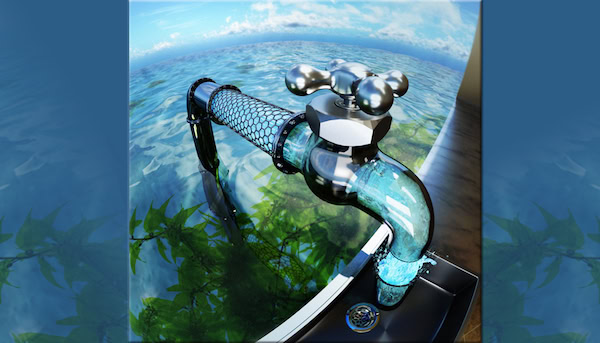
[Image above] An artist’s depiction of a stylized carbon nanotube pipe that delivers clean desalinated water from the ocean to a kitchen tap. Credit: Ryan Chen; LLNL
As we drink our clean, filtered, or bottled water, we often don’t stop to think that there are many regions of the world that don’t even have access to this important resource. In fact, a recent report by the World Health Organization indicates that 844 million people lack access to a basic drinking water service, and 159 million people still collect drinking water directly from surface water sources.
Although we take it for granted, we should consider ourselves lucky to be able to turn on a faucet and get clean water.
It’s hard to believe that many people don’t have this luxury. After all, water covers nearly three-fourths of the Earth’s surface (71%). The oceans represent about 97% of the Earth’s water—so why can’t we tap into the ocean to get water?
It’s a lot more complicated than it sounds. Desalination is the process of removing salt from seawater. Current desalination plants require a lot of energy and expense to pull all that salt out of the seawater.
But a recent collaboration between researchers at Lawrence Livermore National Laboratory (LLNL) and Northeastern University has resulted in a new process to potentially generate clean water from the ocean. The scientists created carbon nanotube straws—measuring more than 50,000 times thinner than a human hair—that can filter salt molecules from ocean water.
Discovered in the early ‘90s, carbon nanotubes are essentially sheets of graphene rolled up in the shape of a tube. They are stronger than steel and better conductors than copper.
“It’s basically a straw that’s made of carbon, but the ones that we use are actually really narrow straws—and they are so narrow that basically you can only fit a water molecule in those straws, one at a time,” Alex Noy, senior research scientist at LLNL and principal investigator for the research project, explains in a video.
The thin carbon nanotubes are just 0.8 nm wide. They are water permeable, but their most important functionality lies in the tiny pores that prevent salt ions from passing through.
The team had experimented with carbon nanotubes larger than 1 nm. Although they were more efficient at transporting water faster, they weren’t as efficient in filtering out the salt—which is the most important function when you’re trying to make clean water.
Not only are the salt ions bigger than the width of the nanotubes that the team is using, but the charges at the end of the nanotube reject positive and negative salt ions, Ramya Tunuguntla, postdoc researcher at LLNL and co-author of the team’s paper, reports in the video.
Researchers have been exploring the use of carbon nanotubes for years. They have been successful in filtering out things like heavy metals and other water contaminants. And they’ve also been known to outperform silicon for use in transistors. Scientists have even found a way to make super sponges out of them.
“Their sub-nanometer size, atomically smooth surfaces and similarity to cellular water transport channels make [carbon nanotubes] exceptionally suited for this purpose, and it is very exciting to make a synthetic water channel that performs better than nature’s own,” Noy says in LLNL’s news release.
“We were interested in studying the fundamental water and ion transport rates of these carbon nanotube porins, as there were previously a lack of experimental methods to measure such properties,” Tunuguntia writes in an email. “Now that we have an understanding of the water flux and the mechanisms that allow such a great enhancement even compared to biological gold standards, we can now begin to address how to make a robust and scalable system.”
The paper, published in Science, is “Enhanced water permeability and tunable ion selectivity in subnanometer carbon nanotube porins” (DOI: 10.1126/science.aan2438)
Watch the video below to learn more about the research.

Credit: Lawrence Livermore National Laboratory; YouTube
Author
Faye Oney
CTT Categories
- Basic Science
- Environment
- Material Innovations
- Nanomaterials


